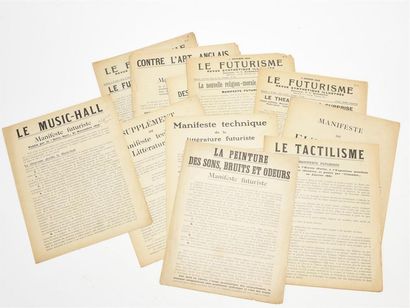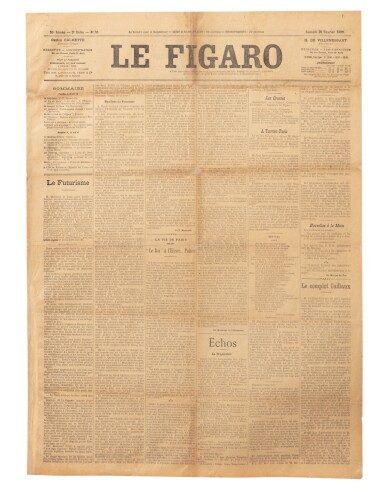Marinetti, Filippo Tommaso SI = NO.Circa 1915. A very rich paroliberist composition. Original sketch. Ink on paper, bifolio, back of a letterhead from the Palace Hotel, Brussels. 26.5 x 20.5 cm. Marinetti makes full use of his entire words-in-freedom stylistic arsenal: made-up words (“Krucani”), mathematical formulas (“SI = NO”; "Kruc = 0+2"), repeated letters (“Assssomaaaa”) or words (“farfarfarfarfar”), letters that are also pictures, etc.The expression “SI = NO” [“YES = NO”] is reminiscent of the title of D'Annunzio's novel, Forse che sì forse che no [Maybe yes, maybe no]. This novel of the modern age, published in 1910, developed several themes - speed, airplanes, superman - that closely paralleled those of the Futurists; Marinetti acknowledged the “absolutely Futurist conception” of the novel (quoted by St. Bragato, p. 63). When, in January 1921, the Dadaists published their anti-futurist tract “Dada Stirs Up Everything”, they seemed to draw their inspiration from this 1915 composition by Marinetti and his mathematical formulation “SI = NO”: “YES = NO”. Has Dada ever spoken to you: of Italy [...], of D'Annunzio, [...]? The Futurist is dead. What did it die of? Dada.”_____________________________________________________________ Marinetti, Filippo Tommaso SI = NO.Circa 1915. Très riche composition motlibriste. Dessin original. Encre sur papier, au verso d’un bifeuillet en-tête du Palace Hôtel, Bruxelles. 26,5 x 20,5 cm. Marinetti y déploie tout son arsenal stylistique des mots en liberté : mots inventés ("Krucani"), formules mathématiques ("SI = NO" ; "Kruc = 0+2"), répétitions de lettres ("Assssomaaaa") ou de mots ("farfarfarfarfar"), lettres qui sont aussi dessins, etc. L’expression "SI = NON" ["OUI = NON"] n’est pas sans évoquer le titre du roman de D’Annunzio, Forse che sì forse che no [Peut-être bien que oui, peut-être bien que non]. Ce roman de la modernité publié en 1910 développait plusieurs thématiques — vitesse, avion, surhomme — proches des futuristes ; Marinetti reconnaîtra dans le roman une "conception absolument futuriste" (cité par St. Bragato, p. 63). Quand, en janvier 1921, les dadaïstes publient leur tract anti-futuriste Dada soulève tout, ils semblent s’inspirer de cette composition de Marinetti et de sa formulation mathématique "SI = NO" : "OUI = NON" de 1915. Dada vous a-t-il jamais parlé : de l’Italie […], de D’Annunzio, […] ? Le futuriste est mort. De quoi ? De Dada."Condition reportTo request a
Marinetti, Filippo Tommaso SI = NO.Circa 1915. A very rich paroliberist composition. Original sketch. Ink on paper, bifolio, back of a letterhead from the Palace Hotel, Brussels. 26.5 x 20.5 cm. Marinetti makes full use of his entire words-in-freedom stylistic arsenal: made-up words (“Krucani”), mathematical formulas (“SI = NO”; "Kruc = 0+2"), repeated letters (“Assssomaaaa”) or words (“farfarfarfarfar”), letters that are also pictures, etc.The expression “SI = NO” [“YES = NO”] is reminiscent of the title of D'Annunzio's novel, Forse che sì forse che no [Maybe yes, maybe no]. This novel of the modern age, published in 1910, developed several themes - speed, airplanes, superman - that closely paralleled those of the Futurists; Marinetti acknowledged the “absolutely Futurist conception” of the novel (quoted by St. Bragato, p. 63). When, in January 1921, the Dadaists published their anti-futurist tract “Dada Stirs Up Everything”, they seemed to draw their inspiration from this 1915 composition by Marinetti and his mathematical formulation “SI = NO”: “YES = NO”. Has Dada ever spoken to you: of Italy [...], of D'Annunzio, [...]? The Futurist is dead. What did it die of? Dada.”_____________________________________________________________ Marinetti, Filippo Tommaso SI = NO.Circa 1915. Très riche composition motlibriste. Dessin original. Encre sur papier, au verso d’un bifeuillet en-tête du Palace Hôtel, Bruxelles. 26,5 x 20,5 cm. Marinetti y déploie tout son arsenal stylistique des mots en liberté : mots inventés ("Krucani"), formules mathématiques ("SI = NO" ; "Kruc = 0+2"), répétitions de lettres ("Assssomaaaa") ou de mots ("farfarfarfarfar"), lettres qui sont aussi dessins, etc. L’expression "SI = NON" ["OUI = NON"] n’est pas sans évoquer le titre du roman de D’Annunzio, Forse che sì forse che no [Peut-être bien que oui, peut-être bien que non]. Ce roman de la modernité publié en 1910 développait plusieurs thématiques — vitesse, avion, surhomme — proches des futuristes ; Marinetti reconnaîtra dans le roman une "conception absolument futuriste" (cité par St. Bragato, p. 63). Quand, en janvier 1921, les dadaïstes publient leur tract anti-futuriste Dada soulève tout, ils semblent s’inspirer de cette composition de Marinetti et de sa formulation mathématique "SI = NO" : "OUI = NON" de 1915. Dada vous a-t-il jamais parlé : de l’Italie […], de D’Annunzio, […] ? Le futuriste est mort. De quoi ? De Dada."Condition reportTo request a
.jpg)













Testen Sie LotSearch und seine Premium-Features 7 Tage - ohne Kosten!
Lassen Sie sich automatisch über neue Objekte in kommenden Auktionen benachrichtigen.
Suchauftrag anlegen